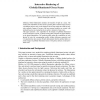Free Online Productivity Tools
i2Speak
i2Symbol
i2OCR
iTex2Img
iWeb2Print
iWeb2Shot
i2Type
iPdf2Split
iPdf2Merge
i2Bopomofo
i2Arabic
i2Style
i2Image
i2PDF
iLatex2Rtf
Sci2ools
RT
1997
Springer
1997
Springer
Interactive Rendering of Globally Illuminated Glossy Scenes
Global illumination simulates all transfers of light in a scene. The results of the simulation are then used to generate photo-realistic images. Scenes with diffuse surfaces only can be displayed in real-time using the results of radiosity methods. Images of scenes with more general surfaces are created with methods based on ray tracing but do not achieve interactive frame rates. This paper presents a new algorithm for the display of globally illuminated scenes at interactive speeds. A photon tracing phase computes an approximation to the global illumination. The rendering phase splats the contribution of each photon hit onto the corresponding surface taking reflectance properties and viewing direction into account. Results demonstrate that this method allows to render images of globally illuminated scenes with glossy surfaces at interactive frame rates.
Computer Graphics | Global Illumination | Interactive Frame Rates | Photon Tracing Phase | RT 1997 |
| Added | 08 Aug 2010 |
| Updated | 08 Aug 2010 |
| Type | Conference |
| Year | 1997 |
| Where | RT |
| Authors | Wolfgang Stürzlinger, Rui Bastos |
Comments (0)

